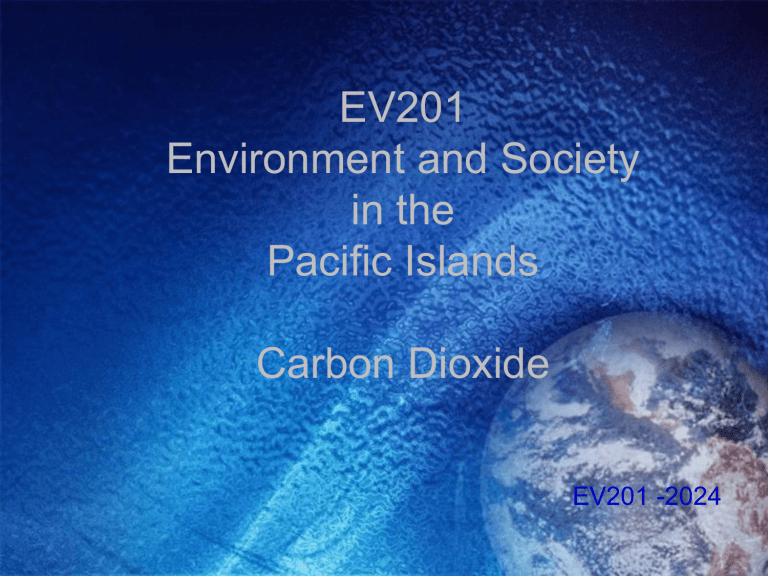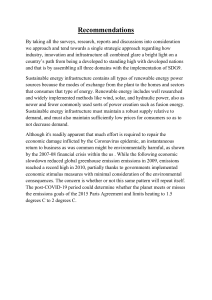
EV201 Environment and Society in the Pacific Islands Carbon Dioxide EV201 -2024 Impacts of climate change • Potential agricultural losses • Islands and coastal areas lost to sea level rise • Species extinction and ecosystem collapse • Increase in disease incidence • These impacts will be felt most strongly by those who are too poor to mitigate or adapt to climate change impacts. Institutions: Climate free-riders and carbon cooperation • Impacts are not necessarily felt where CO2 is emitted • All countries would benefit from a reduction of greenhouse gas emissions • Assuming that cuts in emissions would put someone at economic disadvantage, only those who make reductions will pay – Who should pay? Cartogram of Carbon Emissions Source: http://www.viewsoftheworld.net/?p=1976. CC BY-NC-ND 3.0 Reducing emissions • Developed countries – Emitted most of the CO2 in the atmosphere in order to become developed – Emit more CO2 per capita than less developed countries • Developing countries – Emit less CO2 per capita, but have higher population growth – If they eventually emit as much per capita as developed countries, they will have higher total emissions as well So how can we develop incentives to reduce emissions? Overcoming barriers through flexibility: the Kyoto Protocol • An agreement between signatory countries to reduce carbon emissions – Rules can change over time with new information – Reduction targets are dispersed over time to allow time to develop new technology or regulations – Countries can trade emissions with each other – Annex 1 (developed) countries have earlier and mandatory cuts, share technology with Annex 2 – Annex 2 (less developed) countries have voluntary cuts Overcoming barriers through flexibility: the Kyoto Protocol • Some see the Kyoto Protocol as shallow and weak, but it has been a good start to further negotiations and more action – Many have adopted more strict controls than what was called for in the original protocol – Local institutional efforts such as the U.S. Conference of Mayors’ Climate Protection Agreement Markets: Trading more gases, buying less carbon • For a market environmentalist: – Emissions are an externality – Command-and-control (regulation) is inefficient, so market-based solutions are the best way to account for the costs • Possible solutions: – Cap and trade – Carbon offsets Trading carbon • Cap and trade – Emissions are capped at a certain level – A company or country that wants to emit more will buy the right to emit from a company or country that can emit less Green carbon consumption • People can pay the producer not to emit by purchasing low-emissions products • People can pay to offset carbon emitted – E.g., programs where money pays to plant more trees to sequester carbon Joy of Tech comic courtesy of geekculture.com The strange logic of carbon offsets Political economy: Who killed the atmosphere? • Market mechanisms are the most popular way to deal with carbon emissions • But, if capital accumulation created the problem, how can we expect it to get us out of this mess? Political economy: Green consumption is still consumption • Uneven development – Wealthiest people produce the most carbon but are the least affected by the impacts – Those who are affected most cannot afford to use money to express their preference • 2nd contradiction of capital – Capital accumulation requires consumption – Consumption uses up resources, produces waste, and degrades the environment Critiques of carbon markets • Greenwashing – marketing products or services as environmentally friendly without substantial efforts to reduce impacts – Cannot be sure that carbon offset programs will actually offset carbon – Carbon offset programs may benefit wealthier countries and disadvantage poorer countries Climate policy in political economy • Markets and institutions have not successfully reduced carbon in the atmosphere – They HAVE been successful at concentrating power and wealth • Political economists prefer regulatory solutions instead of markets because contradictions in the economy are producing the problem in the first place Historical Carbon Emissions http://www.globalissues.org/article/231/climate-justice-and-equity Historical Carbon Emissions • By 2008, the rich nations had already counted for the majority of carbon emissions, since 1800: 240 gigatons (Gt), vs 91 Gt from the rest of the world: It is likely that emissions by 2050 will mean rich countries have ended up using some 325 Gt (of the 600 total that is aimed for), or just over 50%. Yet, it needs to be around 20% (because the rich nations are roughly 20% of the population): http://www.globalissues.org/article/231/climate-justice-and-equity Historical Carbon Emissions http://www.globalissues.org/article/231/climate-justice-and-equity





